Stationary vs Stationery. What is the difference?
Hey there, language enthusiasts! Ever find yourself scratching your head over those tricky words that sound alike but mean totally different things?
Well… you’re not alone!
English is full of these sneaky words that can trip us up if we’re not careful.
But fear not… because today we’re going to tackle one such pair:
“Stationary” and “Stationery.”
Stick around as we dive into the fascinating world of stationary vs. stationery and unravel the mystery behind these commonly confused terms.
Ready to roll?
Let’s get started!
Short answer:
“Stationary” refers to something that is not moving, like a stationary bike.
“Stationery” refers to writing materials such as paper, envelopes, and pens.
Definition of “Stationary”
“Stationary” means NOT moving or fixed in one place.
Examples of “Stationary” usage in daily routine
“The book was placed on the stationary shelf.”
“The traffic was at a complete standstill, so the cars remained stationary.”
“After finishing my workout, I sat on the stationary bike for a cool-down.”
“The statue in the park remained stationary, attracting many visitors.”
“I took a stationary position to capture the perfect photo of the sunset.”
“During the lecture, the professor remained stationary at the podium.”
The stationary phase of the traffic light lasted for several minutes.”
“The Earth’s orbit around the Sun is not perfectly stationary.”
“The weather forecast predicted a stationary front, leading to stable conditions.”
“In yoga class, we practiced stationary poses to improve balance and strength.”
Definition of “Stationery”
“Stationery” refers to writing materials and office supplies, including paper, envelopes, pens, pencils, erasers, and other items used for writing, drawing, or organizing.
How to use the word “Stationery” in ordinary life
“I need to buy some stationery for school, like notebooks and pens.”
“Can you pass me the stationery drawer? I need an envelope to mail this letter.”
“I love browsing stationery stores to see all the different types of paper and designs.”
“Let’s pick out some cute stationery for our wedding invitations.”
“I keep all my stationery organized in a desk organizer on my desk.”
“Do you have any stationery recommendations for bullet journaling?”
“My favorite part of back-to-school shopping is picking out new stationery supplies.”
“I’m going to personalize my stationery with my initials for a unique touch.”
“I like to support small businesses by purchasing handmade stationery items from local artisans.”
Practical Tips for Distinguishing Between “Stationary” and “Stationery”
Comparison Table
| Criteria | Stationary | Stationery |
|---|---|---|
| Definition | Not moving or fixed in one place. | Writing materials such as paper, envelopes, etc. |
| Example | A parked car | A letter-writing set |
| Usage | Describing objects or people at rest. | Writing materials used for correspondence. |
| Associated Action | Staying in one position. | Writing or sending letters. |
| Mnemonic | Think of “still” or “stay” for “stationary.” | Remember “envelope” for “stationery.” |
| Visual | Imagine a stationary train at a station. | Picture a desk filled with writing supplies. |
| Related Words | Still, immobile, fixed. | Paper, pen, envelope, letter. |
| Memory Aid | Associate with “car” or “stand still.” | Think of “writing supplies” or “letters.” |
| Usage Contexts | Traffic, physics, photography. | Office, school, correspondence. |
| Common Misunderstandings | Often confused with “stationery.” | Sometimes misspelled as “stationary.” |
5 usefull sources to improve your grammar
“The Power of Babel: A Natural History of Language” by John H. McWhorter
This fascinating book explores the evolution and diversity of languages around the world, offering insights into how languages develop, change, and shape human communication.

“Grammar Girl’s Quick and Dirty Tips for Better Writing” by Mignon Fogarty
With its practical tips and easy-to-understand explanations, this book helps readers improve their writing skills by addressing common grammar and writing issues in a clear and engaging manner.

“The Sense of Style: The Thinking Person’s Guide to Writing in the 21st Century” by Steven Pinker
Drawing on insights from linguistics and cognitive science, Steven Pinker offers a refreshing perspective on writing style, emphasizing clarity, coherence, and elegance in communication.

“Between You & Me: Confessions of a Comma Queen” by Mary Norris
In this humorous and insightful memoir, Mary Norris, a longtime copy editor at The New Yorker, shares anecdotes and advice about language, grammar, and the joys of editing.

“The Etymologicon: A Circular Stroll through the Hidden Connections of the English Language” by Mark Forsyth
Taking readers on a delightful journey through the etymology of English words, this book reveals surprising connections and histories behind familiar terms, making language study both entertaining and enlightening.

